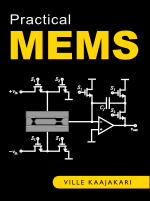These tutorials are my contribution to making the web a more useful entity. Hopefully you'll enjoy them!
Silicon as an anisotropic material
 Have you ever
wondered where all those different values for silicon Young's modulus
come from? Then the "Silicon as an anisotropic mechanical material"-tutorial (a pdf-file) is for you. This four page paper reviews the
crystallographic notation and shows how to calculate the silicon Young's modulus and Poisson's ratio from the stiffness tensor in any
crystal direction. You may also want to download
this Matlab script
for your own calculations.
Have you ever
wondered where all those different values for silicon Young's modulus
come from? Then the "Silicon as an anisotropic mechanical material"-tutorial (a pdf-file) is for you. This four page paper reviews the
crystallographic notation and shows how to calculate the silicon Young's modulus and Poisson's ratio from the stiffness tensor in any
crystal direction. You may also want to download
this Matlab script
for your own calculations.
Noise in micromechanical systems
 When you
miniaturize mechanics, surprising things start to happen. One result
is that the mechanical noise becomes significant or even performance
limiting factor as the device size is shrunk to micron scale. The "Noise in micromechanical
systems"-tutorial (a pdf-file) derives Johnson-Nyguist noise for
mechanical resonators. The noise performance is exemplified by
analyzing the noise micromechanical accelerometer and theoretically
attainable noise
performance is compared to commercial devices.
When you
miniaturize mechanics, surprising things start to happen. One result
is that the mechanical noise becomes significant or even performance
limiting factor as the device size is shrunk to micron scale. The "Noise in micromechanical
systems"-tutorial (a pdf-file) derives Johnson-Nyguist noise for
mechanical resonators. The noise performance is exemplified by
analyzing the noise micromechanical accelerometer and theoretically
attainable noise
performance is compared to commercial devices.
(Electrical) equivalent circuits for MEMS
 Modeling
the micromechanical systems is a challenge as the devices often combine
aspects of physics, mechanics, and electrical circuits. Electrical
equivalent approach offers a simple yet very effective way to model the
systems as all aspects can be analyzed in circuit domain. The "(Electrical) equivalent
circuits for micromechanical systems"-tutorial (a pdf-file) goes
through the steps of developing the electrical equivalent for a
microresonator.
Modeling
the micromechanical systems is a challenge as the devices often combine
aspects of physics, mechanics, and electrical circuits. Electrical
equivalent approach offers a simple yet very effective way to model the
systems as all aspects can be analyzed in circuit domain. The "(Electrical) equivalent
circuits for micromechanical systems"-tutorial (a pdf-file) goes
through the steps of developing the electrical equivalent for a
microresonator.
Pull-in in electrostatic actuators
 The instability or pull-in limits
the controllable displacement in electrostatic atuators. The "Pull-in voltage in electrostatic
microactuators"-tutorial (a pdf-file) goes through the derivation
of the pull-in voltage in electrostatical micromechanical devices.
The instability or pull-in limits
the controllable displacement in electrostatic atuators. The "Pull-in voltage in electrostatic
microactuators"-tutorial (a pdf-file) goes through the derivation
of the pull-in voltage in electrostatical micromechanical devices.
Nonlinearity in micromechanical resonators
 Typically, the intrinsic nonlinearities set the
performance limit of microresonators. In "Nonlinearity in
micromechanical resonators"-tutorial (a pdf-file), the effect of
nonlinear spring forces on (micro)resonators is covered. A
step-by-step perturbation analysis is carried out to analyze the
microresonator power handling capacity. The effect of nonlinear
springs is illustrated with a clamped-clamped beam example that shows
both capacitive and mechanical nonlinearity.
Typically, the intrinsic nonlinearities set the
performance limit of microresonators. In "Nonlinearity in
micromechanical resonators"-tutorial (a pdf-file), the effect of
nonlinear spring forces on (micro)resonators is covered. A
step-by-step perturbation analysis is carried out to analyze the
microresonator power handling capacity. The effect of nonlinear
springs is illustrated with a clamped-clamped beam example that shows
both capacitive and mechanical nonlinearity.
